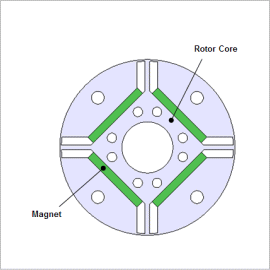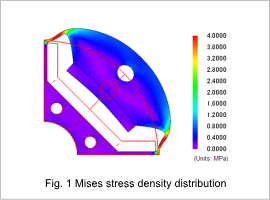*Please prepare a license ID and password for the license administrator.
*It is different from the service for JMAG WEB MEMBER (free membership). Please be careful.
Overview

While motors have started being combined with motor drives and used in a wide range of velocities, further changes toward high output and high efficiency are being demanded of them. While higher speed revolution has been given as a means of attaining higher output, the centrifugal force becomes larger with higher speed revolution and this requires evaluation from the point of mechanical strength.
IPM motors have a structure that embeds the magnet in the rotor. Centrifugal force kicks in during motor drive, so the magnet becomes pressed against the rotor core because it gets peeled off or displaced, making it so that a strong local stress begins to operate. It is necessary to correctly handle the phenomena of a magnet peeling off or becoming displaced in order to accurately obtain the local stress distribution. It is important to account for the adhesion and contact conditions between the magnet and rotor core in an analysis in order to do this.
This Application Note presents examples of cases that obtain changes and stress distribution from the centrifugal force in the rotor.
IPM motors have a structure that embeds the magnet in the rotor. Centrifugal force kicks in during motor drive, so the magnet becomes pressed against the rotor core because it gets peeled off or displaced, making it so that a strong local stress begins to operate. It is necessary to correctly handle the phenomena of a magnet peeling off or becoming displaced in order to accurately obtain the local stress distribution. It is important to account for the adhesion and contact conditions between the magnet and rotor core in an analysis in order to do this.
This Application Note presents examples of cases that obtain changes and stress distribution from the centrifugal force in the rotor.
Mises Stress

Fig. 1 shows the mises stress distribution in the rotor.
Fig. 1 shows that the magnet drastically deforms the rotor core with centrifugal force in the radial direction. Also, the Mises stress increases at the bridge part of the rotor core. Mises stress allows the evaluation of the risks of damaged rotor cores and mechanical strength.
Fig. 1 shows that the magnet drastically deforms the rotor core with centrifugal force in the radial direction. Also, the Mises stress increases at the bridge part of the rotor core. Mises stress allows the evaluation of the risks of damaged rotor cores and mechanical strength.


